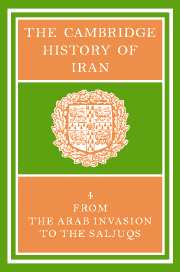Book contents
- Frontmatter
- 1 THE ARAB CONQUEST OF IRAN AND ITS AFTERMATH
- 2 THE ‘ABBĀSID CALIPHATE IN IRAN
- 3 THE ṬĀHIRIDS AND ṢAFFĀRIDS
- 4 The SĀMĀNIDS
- 5 THE EARLY GHAZNAVIDS
- 6 THE MINOR DYNASTIES OF NORTHERN IRAN
- 7 IRAN UNDER THE BŪYIDS
- 8 TRIBES, CITIES AND SOCIAL ORGANIZATION
- 9 THE VISUAL ARTS
- 10 NUMISMATICS
- 11 THE EXACT SCIENCES
- 12 LIFE SCIENCES, ALCHEMY AND MEDICINE
- 13(a) PHILOSOPHY AND COSMOLOGY
- (b) SŪFISM
- 14 THE RELIGIOUS SCIENCES
- 15 SECTS AND HERESIES
- 16 NĀSIR-I KHUSRAU AND IRANIAN ISMĀ‘ĪLĪSM
- 17 ZOROASTRIAN LITERATURE AFTER THE MUSLIM CONQUEST
- 18 ARABIC LITERATURE IN IRAN
- 19 THE RISE OF THE NEW PERSIAN LANGUAGE
- 20 (a) THE “RUBĀ'Ī” IN EARLY PERSIAN LITERATURE
- (b) ‘UMAR KHAYYĀM: ASTRONOMER, MATHEMATICIAN AND POET
- Bibliography
- Index
- Plate section
- Plate section">
- Map 1. Iran under the Abbasids">
- References
19 - THE RISE OF THE NEW PERSIAN LANGUAGE
Published online by Cambridge University Press: 28 March 2008
- Frontmatter
- 1 THE ARAB CONQUEST OF IRAN AND ITS AFTERMATH
- 2 THE ‘ABBĀSID CALIPHATE IN IRAN
- 3 THE ṬĀHIRIDS AND ṢAFFĀRIDS
- 4 The SĀMĀNIDS
- 5 THE EARLY GHAZNAVIDS
- 6 THE MINOR DYNASTIES OF NORTHERN IRAN
- 7 IRAN UNDER THE BŪYIDS
- 8 TRIBES, CITIES AND SOCIAL ORGANIZATION
- 9 THE VISUAL ARTS
- 10 NUMISMATICS
- 11 THE EXACT SCIENCES
- 12 LIFE SCIENCES, ALCHEMY AND MEDICINE
- 13(a) PHILOSOPHY AND COSMOLOGY
- (b) SŪFISM
- 14 THE RELIGIOUS SCIENCES
- 15 SECTS AND HERESIES
- 16 NĀSIR-I KHUSRAU AND IRANIAN ISMĀ‘ĪLĪSM
- 17 ZOROASTRIAN LITERATURE AFTER THE MUSLIM CONQUEST
- 18 ARABIC LITERATURE IN IRAN
- 19 THE RISE OF THE NEW PERSIAN LANGUAGE
- 20 (a) THE “RUBĀ'Ī” IN EARLY PERSIAN LITERATURE
- (b) ‘UMAR KHAYYĀM: ASTRONOMER, MATHEMATICIAN AND POET
- Bibliography
- Index
- Plate section
- Plate section">
- Map 1. Iran under the Abbasids">
- References
Summary
INTRODUCTIONo
New Persian literature, like that of many other countries, begins with poetry. According to the earliest anthology, the Lubāb al-albāb of Muhammad ‘Aufi (618/1221–2), the first Persian poem was a qasīda composed in 193/809 by a certain ‘Abbās or Abu'l-‘Abbās of Marv on the occasion of the entry into that city of the future caliph Ma'mūn. This information is very questionable, however, and the few couplets quoted by ‘Aufī are certainly apocryphal, for the command of classical rhetoric in them is unlikely to be achieved in a first attempt. In fact the earliest poems which have been preserved date from the middle of the 3rd/9th century. The Tārīkh-i Sistān, a local chronicle compiled in the 5th/11th century, attributes the production of the first poetry in Persian to the Sīstānians. According to this interesting account, the victory of Ya‘qūb b. al-Laith the Saffārid over the Khārijite ‘Ammār in 251/865 was celebrated after the custom of the time by panegyrics in Arabic. Ya‘qūb was an uneducated military leader (condottiere) with no knowledge of Arabic. “Why,” he asked, “do you compose verses which I do not understand?” One of his secretaries, Muhammad b. Vasīf, then had the idea of composing in the same strain a qasida in Persian, which is quoted in the Tārīkh-i Sīstān, and his example was followed by two of his compatriots. The anthologies make no mention of these Sīstānian poets, but the Chahār maqāla of Nizāmī ‘Arūdi (550–1/1155–7) and the Lubāb al-albāb of ‘Aufī quote some verses by a poet of the Herāt region, Hanzala of Bādghīs, whose work is certainly earlier in date than 259/873. Both traditions therefore attribute the beginnings of Persian classical poetry to the same period.
Keywords
- Type
- Chapter
- Information
- The Cambridge History of Iran , pp. 595 - 632Publisher: Cambridge University PressPrint publication year: 1975
References
- 14
- Cited by

